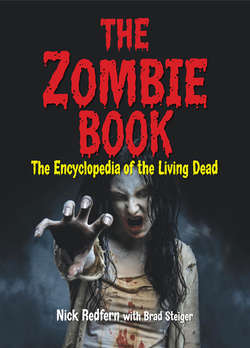Читать книгу The Zombie Book - Nick Redfern - Страница 48
На сайте Литреса книга снята с продажи.
Cemeteries and Tombs See also: Burial Traditions, Cremation, Funerals, Mummies
ОглавлениеThe marking of graves goes back into remote antiquity. The ancient Hebrews buried their dead and used stone pillars to mark the graves. The Greeks often placed gravestones and various kinds of ornate sculpture on their burial sites.
The Assyrians (c. 750–612 B.C.E.) dug huge excavations which sometimes reached a depth of sixty feet into which they cast the bodies of their dead, one upon the other. Even when they began to place their dead in coffins, the Assyrians continued to pile one above the other in great excavations.
The Iberians, the original people who inhabited the peninsula where modern day Portugal and Spain exist, buried their leaders with great pomp and ceremony in chambers made of huge stones, covered over with earth. The bodies were placed in these megalithic chambers in a sitting posture. The Aryans, an Indo-European people, burned their dead and placed the ashes in urns shaped like rounded huts with thatched roofs.
Decorating graves with flowers and wreaths is an old custom which appears to date back to the earliest human burial observances. Wreaths made of thin gold have been found in Athenian graves during archaeological excavations. The Egyptians adorned their mummies with flowers, and paintings on the walls of tombs that depict the mourners carrying flowers in their hands.
Not everyone who died in ancient Egypt was buried in a tomb. Although the Egyptians believed firmly in an afterlife, they were also of the opinion that only the powerful and important in the earthly life would have any notable status in the world to come. According to rank and wealth, those who were great in Egypt, and therefore likely to be important in the next life, were laid to rest in magnificent tombs with treasure, servants, food, and weapons to accompany them; the ordinary people were buried in rude stone compartments.
The rulers of the ancient city of Thebes, once the capital of upper-Egypt (1580–1085 B.C.E.) and their subjects never constructed massive pyramids to house their coffins, but cut their tombs from rock. As soon as a pharaoh would ascend the throne, his loyal subjects began the preparation of their tombs. Excavation went on uninterrupted, year by year, until death ended the king’s reign and simultaneously the work on his tomb which also became a kind of an index revealing the length of his reign. These tombs, cut from the rock in the mountains in Upper Egypt, are still to be seen.
In sixteenth century Europe, it was customary to make wreaths of flowers from ribbon and paper and give them to the church in memory of the deceased. These artificial wreaths of long ago evolved into the contemporary mourning wreath of living flowers, usually brought by friends or relatives of the deceased and placed upon the grave.
